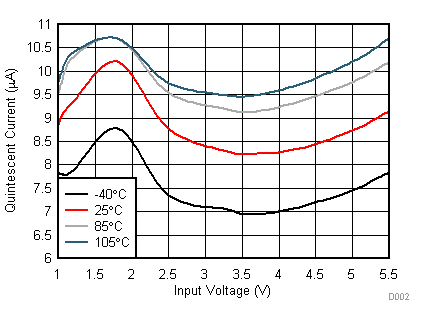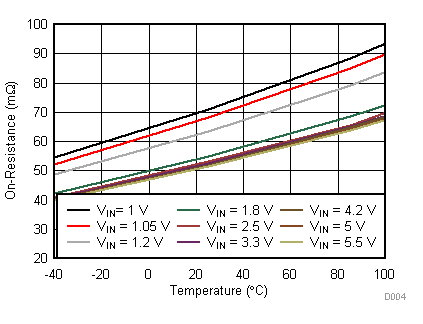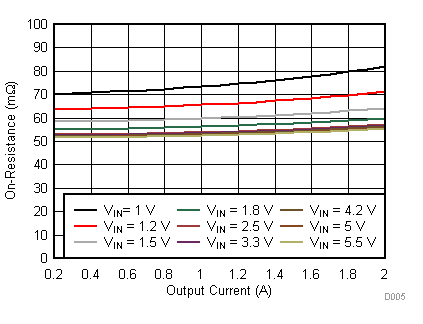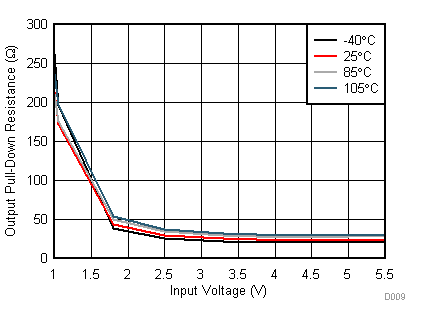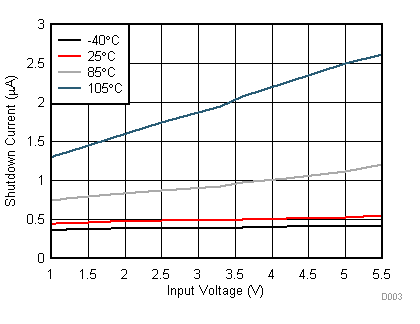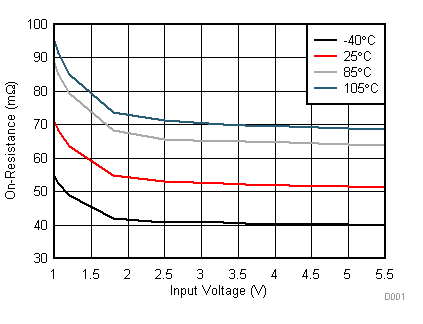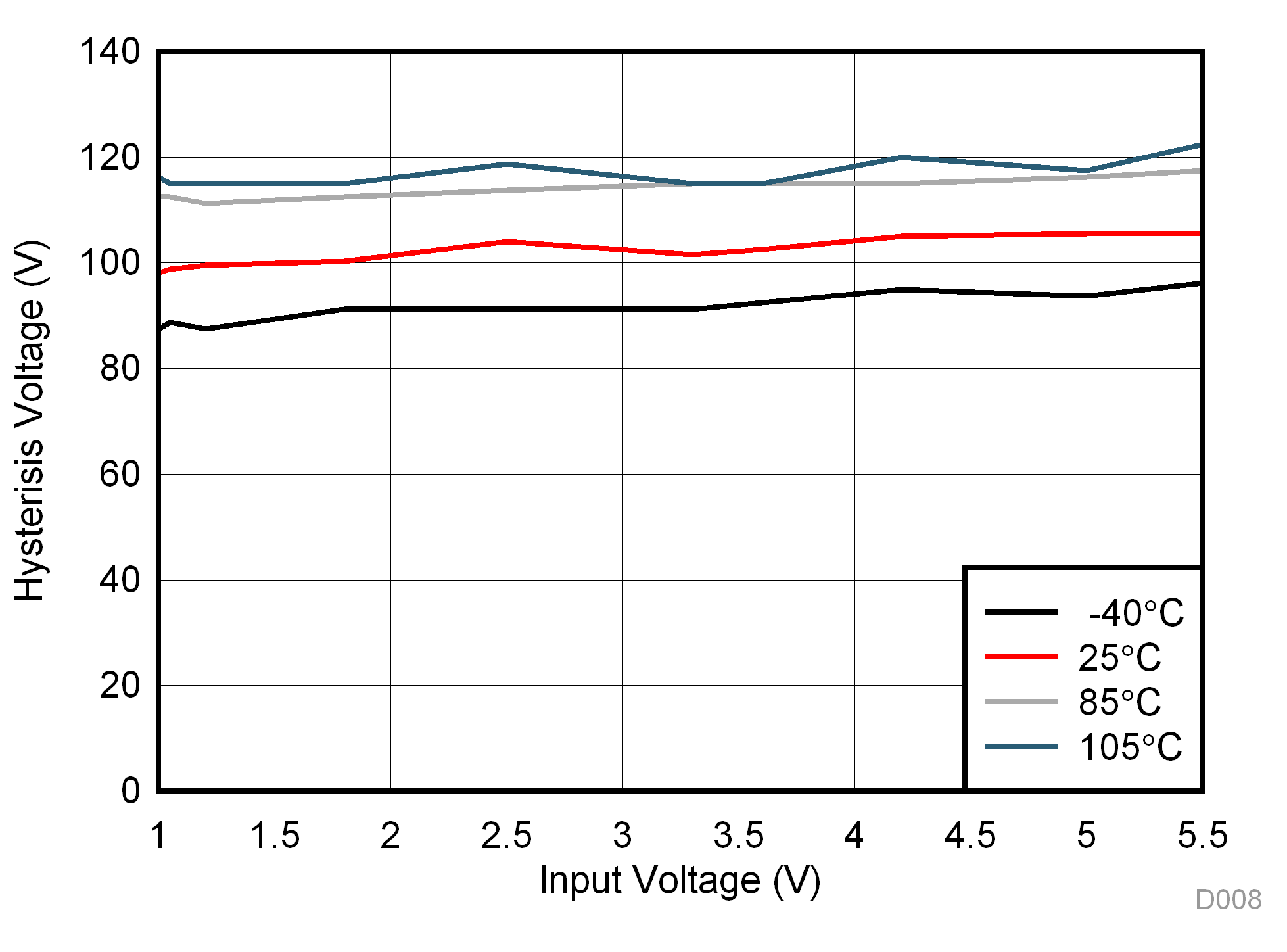ZHCSEX3A February 2016 – March 2016 TPS22918
PRODUCTION DATA.
6 Specifications
6.1 Absolute Maximum Ratings
Over operating free-air temperature range (unless otherwise noted) (1) (2)| MIN | MAX | UNIT | ||
|---|---|---|---|---|
| VIN | Input voltage | –0.3 | 6 | V |
| VOUT | Output voltage | –0.3 | 6 | V |
| VON | ON voltage | –0.3 | 6 | V |
| IMAX | Maximum continuous switch current, ambient temperature = 70°C | 2 | A | |
| IPLS | Maximum pulsed switch current, pulse < 300 µs, 2% duty cycle | 2.5 | A | |
| TJ | Maximum junction temperature | 125 | °C | |
| Tstg | Storage temperature | –65 | 150 | °C |
(1) Stresses beyond those listed under Absolute Maximum Ratings may cause permanent damage to the device. These are stress ratings only, which do not imply functional operation of the device at these or any other conditions beyond those indicated under Recommended Operating Conditions. Exposure to absolute-maximum-rated conditions for extended periods may affect device reliability.
(2) All voltage values are with respect to network ground terminal.
6.2 ESD Ratings
| VALUE | UNIT | |||
|---|---|---|---|---|
| V(ESD) | Electrostatic discharge | Human-body model (HBM), per ANSI/ESDA/JEDEC JS-001 (1) | ±2000 | V |
| Charged-device model (CDM), per JEDEC specification JESD22-C101 (2) | ±1000 | |||
(1) JEDEC document JEP155 states that 500-V HBM allows safe manufacturing with a standard ESD control process.
(2) JEDEC document JEP157 states that 250-V CDM allows safe manufacturing with a standard ESD control process.
6.3 Recommended Operating Conditions
Over operating free-air temperature range (unless otherwise noted)| MIN | MAX | UNIT | |||
|---|---|---|---|---|---|
| VIN | Input voltage | 0 | 5.5 | V | |
| VON | ON voltage | 0 | 5.5 | V | |
| VOUT | Output voltage | VIN | V | ||
| VIH, ON | High-level input voltage, ON | VIN = 1 V to 5.5 V | 1 | 5.5 | V |
| VIL, ON | Low-level input voltage, ON | VIN = 1 V to 5.5 V | 0 | 0.5 | V |
| TA | Operating free-air temperature range (1) | –40 | 105 | °C | |
| CIN | Input Capacitor | 1 (2) | µF | ||
(1) In applications where high power dissipation and/or poor package thermal resistance is present, the maximum ambient temperature may have to be derated. Maximum ambient temperature [TA(max)] is dependent on the maximum operating junction temperature [TJ(MAX)], the maximum power dissipation of the device in the application [PD(MAX)], and the junction-to-ambient thermal resistance of the part/package in the application (θJA), as given by the following equation: TA(MAX) = TJ(MAX) – (θJA × PD(MAX)).
(2) Refer to Application and Implementation section
6.4 Thermal Information
| THERMAL METRIC (1) | TPS22918 | UNIT | |
|---|---|---|---|
| DBV (SOT-23) | |||
| 6 PINS | |||
| RθJA | Junction-to-ambient thermal resistance | 183.2 | °C/W |
| RθJC(top) | Junction-to-case (top) thermal resistance | 151.6 | °C/W |
| RθJB | Junction-to-board thermal resistance | 34.1 | °C/W |
| ψJT | Junction-to-top characterization parameter | 37.2 | °C/W |
| ψJB | Junction-to-board characterization parameter | 33.6 | °C/W |
(1) For more information about traditional and new thermal metrics, see the Semiconductor and IC Package Thermal Metrics application report, SPRA953.
6.5 Electrical Characteristics
Unless otherwise noted, the specification in the following table applies over the full ambient operating temperature–40°C ≤ TA ≤ +105°C. Typical values are for TA = 25°C.
| PARAMETER | TEST CONDITIONS | TA | MIN | TYP | MAX | UNIT | ||
|---|---|---|---|---|---|---|---|---|
| IQ, VIN | Quiescent current | VON = 5 V, IOUT = 0 A | VIN = 5.5 V | –40°C to +105°C | 9.2 | 16 | µA | |
| VIN = 5 V | 8.7 | 16 | ||||||
| VIN = 3.3 V | 8.3 | 15 | ||||||
| VIN = 1.8 V | 10.2 | 17 | ||||||
| VIN = 1.2 V | 9.3 | 16 | ||||||
| VIN = 1 V | 8.9 | 15 | ||||||
| ISD, VIN | Shutdown current | VON = 0 V, VOUT = 0 V | VIN = 5.5 V | –40°C to +105°C | 0.5 | 5 | µA | |
| VIN = 5 V | 0.5 | 4.5 | ||||||
| VIN = 3.3 V | 0.5 | 3.5 | ||||||
| VIN = 1.8 V | 0.5 | 2.5 | ||||||
| VIN = 1.2 V | 0.4 | 2 | ||||||
| VIN = 1 V | 0.4 | 2 | ||||||
| ION | ON pin input leakage current | VIN = 5.5 V, IOUT = 0 A | –40°C to +105°C | 0.1 | µA | |||
| RON | On-Resistance | VIN = 5.5 V, IOUT = –200 mA | 25°C | 51 | 59 | mΩ | ||
| –40°C to +85°C | 71 | |||||||
| –40°C to +105°C | 78 | |||||||
| VIN = 5.0 V, IOUT = –200 mA | 25°C | 52 | 59 | mΩ | ||||
| –40°C to +85°C | 71 | |||||||
| –40°C to +105°C | 79 | |||||||
| VIN = 4.2 V, IOUT = –200 mA | 25°C | 52 | 59 | mΩ | ||||
| –40°C to +85°C | 71 | |||||||
| –40°C to +105°C | 79 | |||||||
| VIN = 3.3 V, IOUT = –200 mA | 25°C | 53 | 59 | mΩ | ||||
| –40°C to +85°C | 71 | |||||||
| –40°C to +105°C | 80 | |||||||
| VIN = 2.5 V, IOUT = –200 mA | 25°C | 53 | 61 | mΩ | ||||
| –40°C to +85°C | 75 | |||||||
| –40°C to +105°C | 80 | |||||||
| VIN = 1.8 V, IOUT = –200 mA | 25°C | 55 | 65 | mΩ | ||||
| –40°C to +85°C | 79 | |||||||
| –40°C to +105°C | 88 | |||||||
| VIN = 1.2 V, IOUT = –200 mA | 25°C | 64 | 77 | mΩ | ||||
| –40°C to +85°C | 88 | |||||||
| –40°C to +105°C | 104 | |||||||
| VIN = 1.0 V, IOUT = –200 mA | 25°C | 71 | 85 | mΩ | ||||
| –40°C to +85°C | 100 | |||||||
| –40°C to +105°C | 116 | |||||||
| VHYS | ON pin hysteresis | VIN = 1 V to 5.5 V | –40°C to +105°C | 107 | mV | |||
| RPD | Output pull down resistance(1) | VIN = 5.0 V, VON = 0 V | 25°C | 24 | Ω | |||
| –40°C to +105°C | 30 | |||||||
| VIN = 3.3 V, VON = 0 V | 25°C | 25 | ||||||
| –40°C to +105°C | 35 | |||||||
| VIN = 1.8 V, VON = 0 V | 25°C | 45 | ||||||
| –40°C to +105°C | 60 | |||||||
(1) Output pull down resistance varies with input voltage. Please see Figure 7 for more information.
6.6 Switching Characteristics
Refer to the timing test circuit in Figure 21 (unless otherwise noted) for references to external components used for the test condition in the switching characteristics table. Switching characteristics shown below are only valid for the power-up sequence where VIN is already in steady state condition before the ON pin is asserted high. VON = 5 V, TA = 25 °C, QOD = Open.| PARAMETER | TEST CONDITIONS | MIN | TYP | MAX | UNIT | |
|---|---|---|---|---|---|---|
| VIN = 5 V | ||||||
| tON | Turn-on time | RL = 10 Ω, CIN = 1 µF, CL = 0.1 µF, CT = 1000 pF | 1950 | µs | ||
| tOFF | Turn-off time | RL = 10 Ω, CIN = 1 µF, CL = 0.1 µF, CT = 1000 pF | 2 | |||
| tR | VOUT rise time | RL = 10 Ω, CIN = 1 µF, CL = 0.1 µF, CT = 1000 pF | 2540 | |||
| tF | VOUT fall time | RL = 10 Ω, CIN = 1 µF, CL = 0.1 µF, CT = 1000 pF | 2 | |||
| tD | Delay time | RL = 10 Ω, CIN = 1 µF, CL = 0.1 µF, CT = 1000 pF | 690 | |||
| VIN = 3.3 V | ||||||
| tON | Turn-on time | RL = 10 Ω, CIN = 1 µF, CL = 0.1 µF, CT = 1000 pF | 1430 | µs | ||
| tOFF | Turn-off time | RL = 10 Ω, CIN = 1 µF, CL = 0.1 µF, CT = 1000 pF | 2 | |||
| tR | VOUT rise time | RL = 10 Ω, CIN = 1 µF, CL = 0.1 µF, CT = 1000 pF | 1680 | |||
| tF | VOUT fall time | RL = 10 Ω, CIN = 1 µF, CL = 0.1 µF, CT = 1000 pF | 2 | |||
| tD | Delay time | RL = 10 Ω, CIN = 1 µF, CL = 0.1 µF, CT = 1000 pF | 590 | |||
| VIN = 1.8 V | ||||||
| tON | Turn-on time | RL = 10 Ω, CIN = 1 µF, CL = 0.1 µF, CT = 1000 pF | 965 | µs | ||
| tOFF | Turn-off time | RL = 10 Ω, CIN = 1 µF, CL = 0.1 µF, CT = 1000 pF | 2 | |||
| tR | VOUT rise time | RL = 10 Ω, CIN = 1 µF, CL = 0.1 µF, CT = 1000 pF | 960 | |||
| tF | VOUT fall time | RL = 10 Ω, CIN = 1 µF, CL = 0.1 µF, CT = 1000 pF | 2 | |||
| tD | Delay time | RL = 10 Ω, CIN = 1 µF, CL = 0.1 µF, CT = 1000 pF | 480 | |||
| VIN = 1 V | ||||||
| tON | Turn-on time | RL = 10 Ω, CIN = 1 µF, CL = 0.1 µF, CT = 1000 pF | 725 | µs | ||
| tOFF | Turn-off time | RL = 10 Ω, CIN = 1 µF, CL = 0.1 µF, CT = 1000 pF | 3 | |||
| tR | VOUT rise time | RL = 10 Ω, CIN = 1 µF, CL = 0.1 µF, CT = 1000 pF | 560 | |||
| tF | VOUT fall time | RL = 10 Ω, CIN = 1 µF, CL = 0.1 µF, CT = 1000 pF | 2 | |||
| tD | Delay time | RL = 10 Ω, CIN = 1 µF, CL = 0.1 µF, CT = 1000 pF | 430 | |||
6.7 Typical Characteristics
6.7.1 DC Characteristics
6.7.2 AC Characteristics
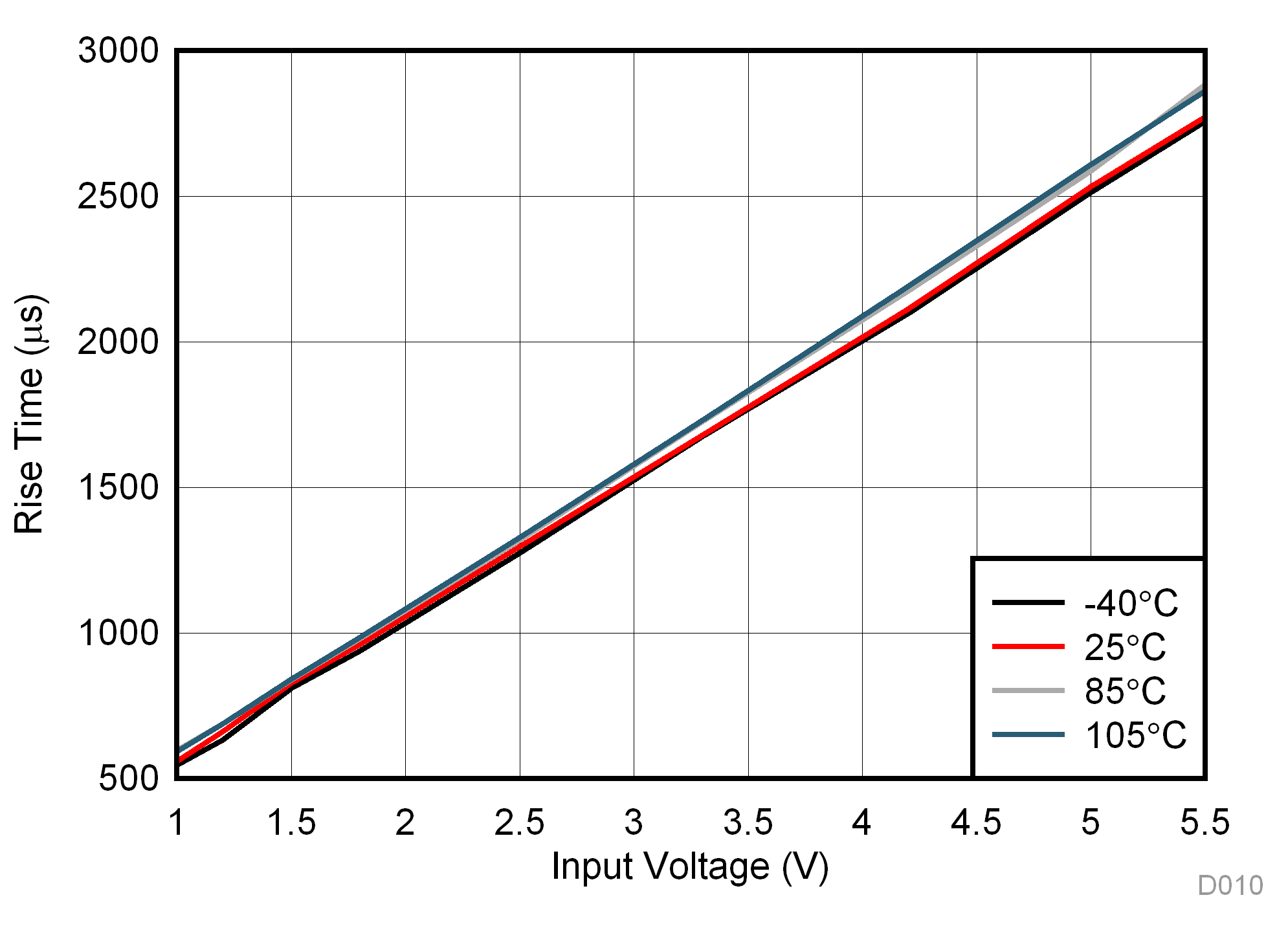
| CIN = 1 µF | RL = 10 Ω | CL = 0.1 µF |
| CT = 1000pF |
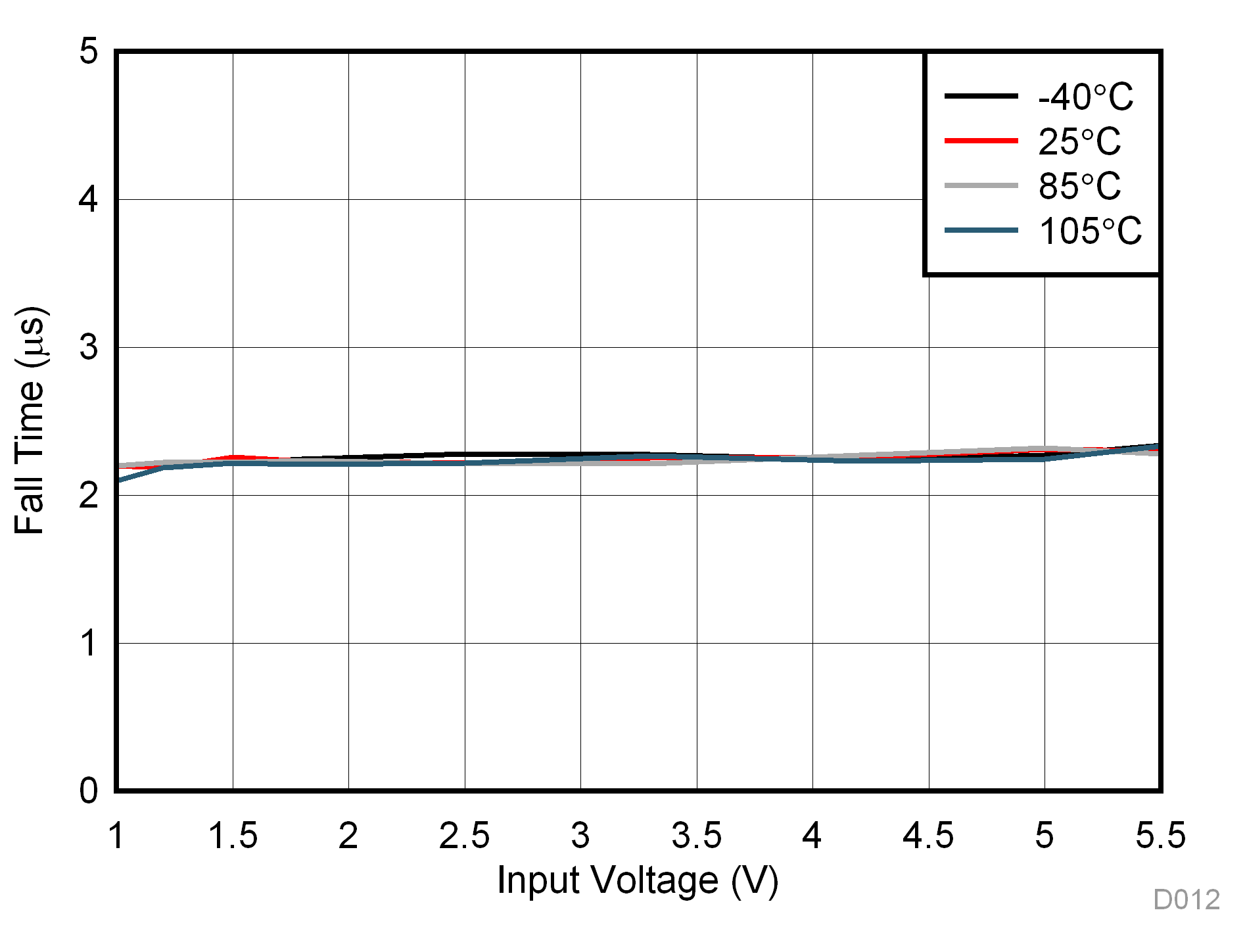
| CIN = 1 µF | RL = 10 Ω | CL = 0.1 µF | QOD = Open |
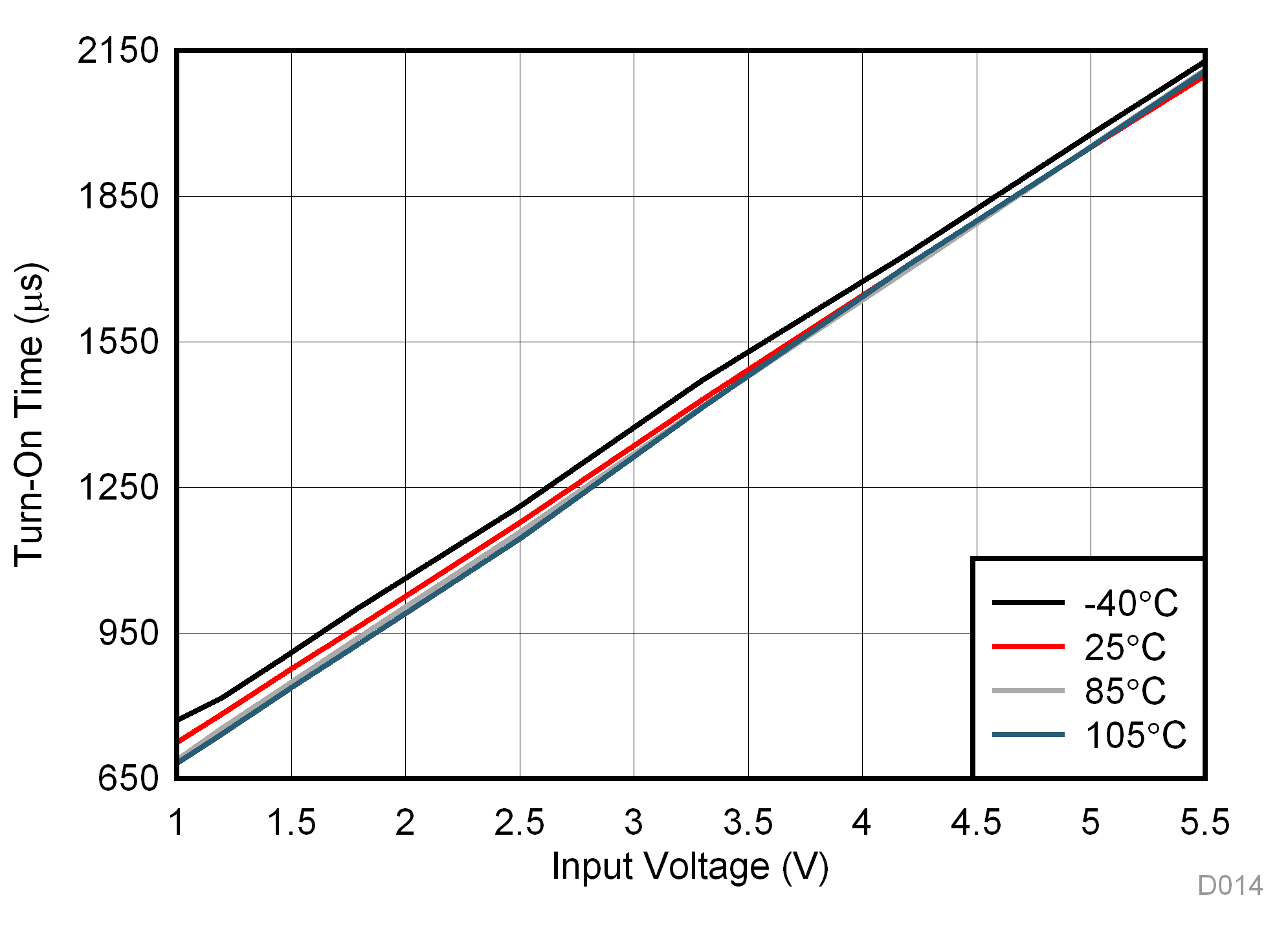
| CIN = 1 µF | RL = 10 Ω | CL = 0.1 µF | ||
| CT = 1000 pF |
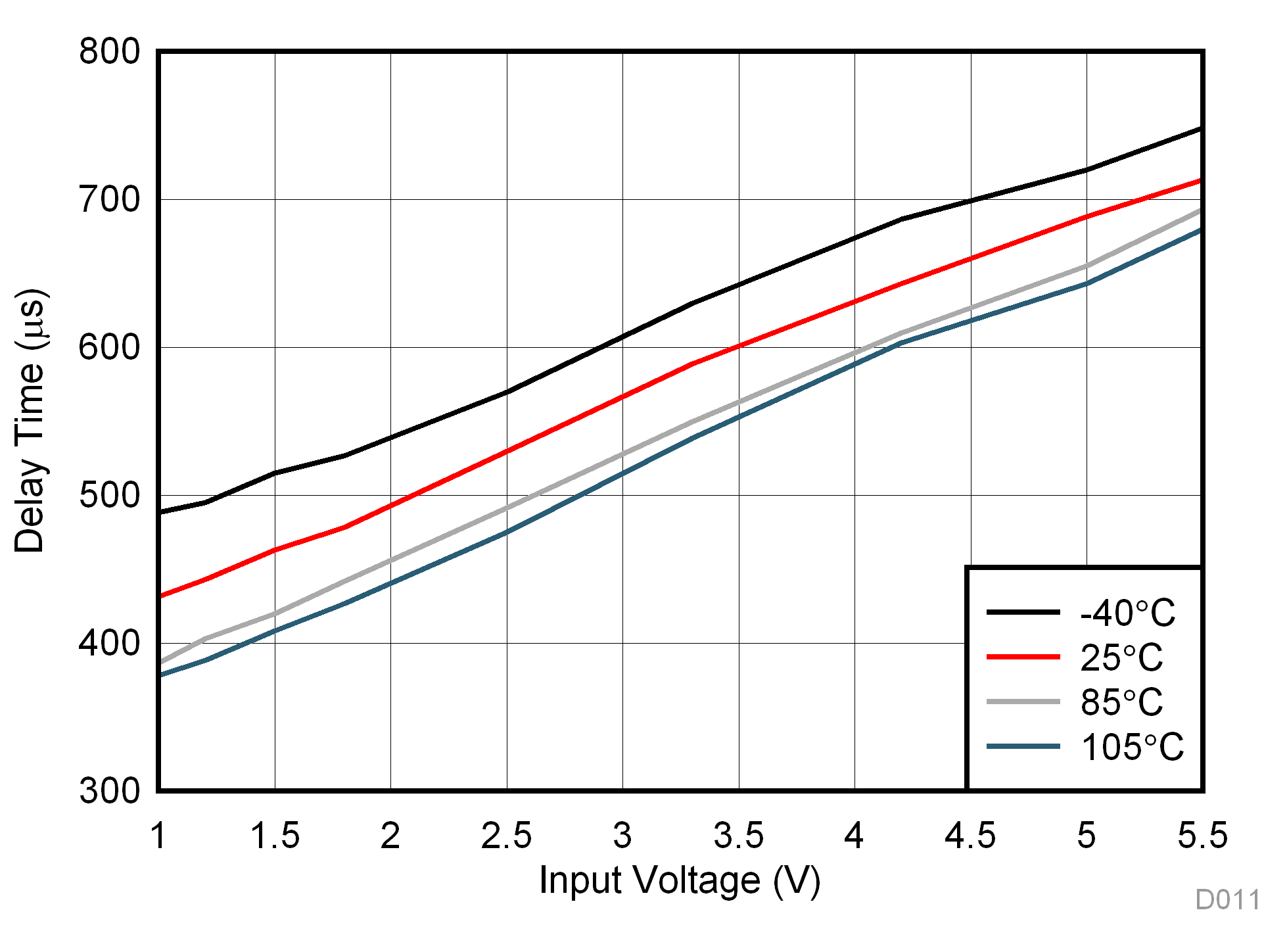
| CIN = 1 µF | RL = 10 Ω | CL = 0.1 µF |
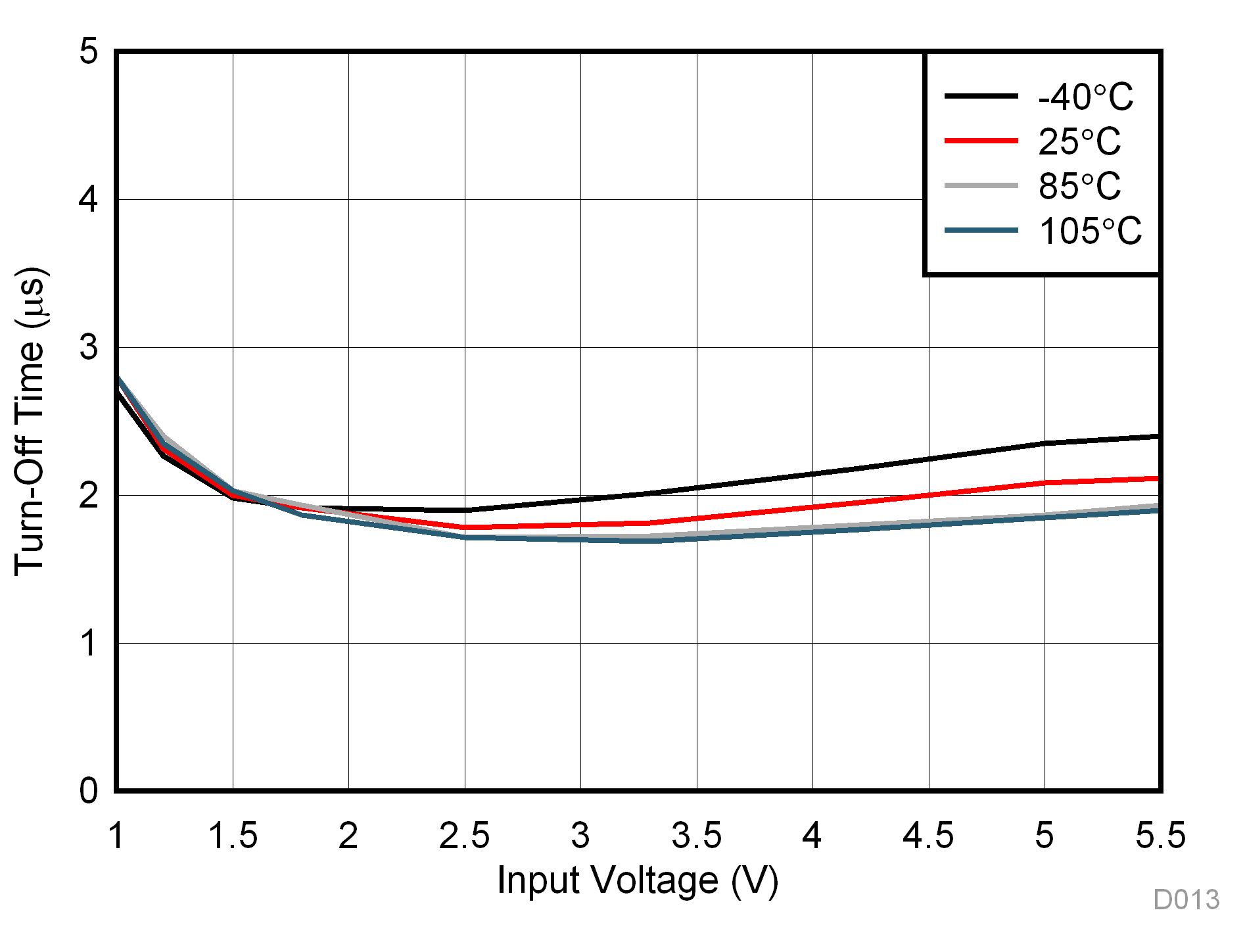
| CIN = 1 µF | RL = 10 Ω | CL = 0.1 µF |
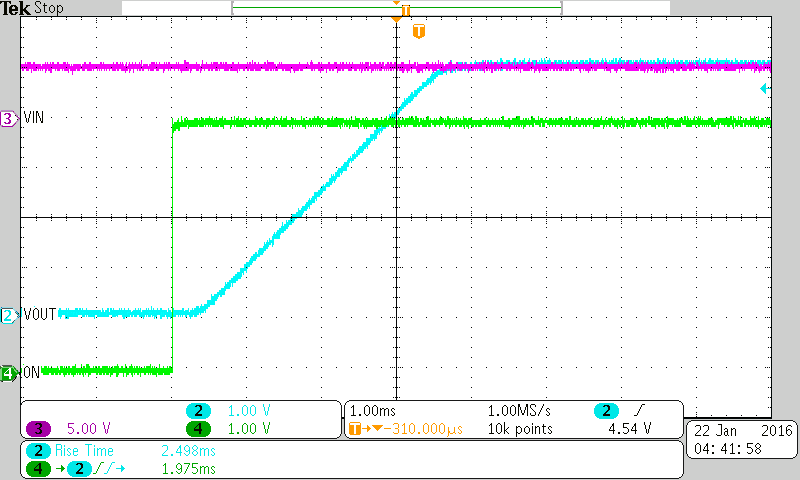
| VIN = 5 V | CIN = 1 µF | CL = 0.1 µF |
| RL = 10 Ω | CT = 1000 pF | |
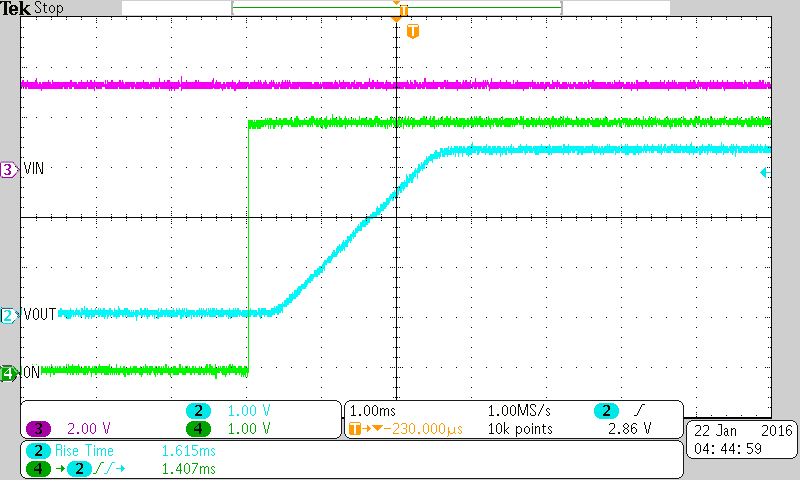
| VIN = 3.3 V | CIN = 1 µF | CL = 0.1 µF |
| RL = 10 Ω | CT = 1000 pF |
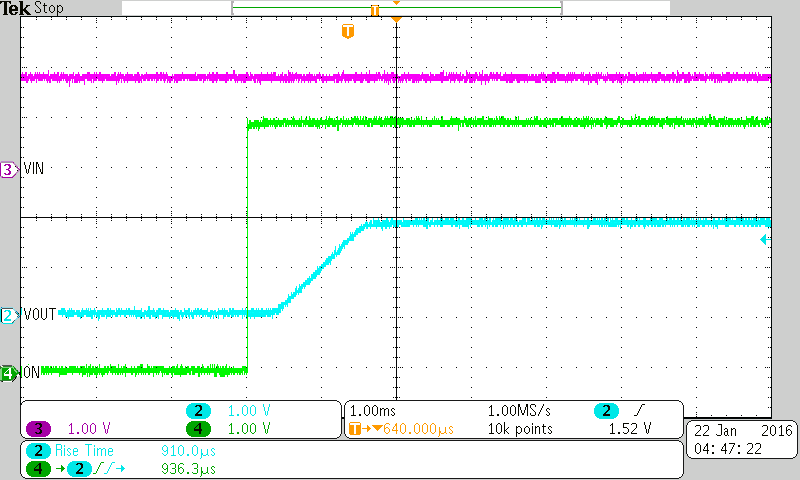
| VIN = 1.8 V | CIN = 1 µF | CL = 0.1 µF |
| RL = 10 Ω | CT = 1000 pF |
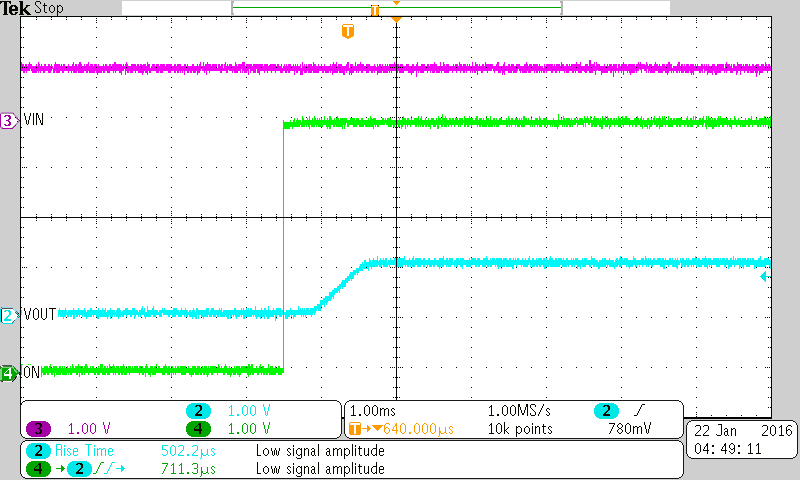
| VIN = 1.0 V | CIN = 1 µF | CL = 0.1 µF |
| RL = 10 Ω | CT = 1000 pF |
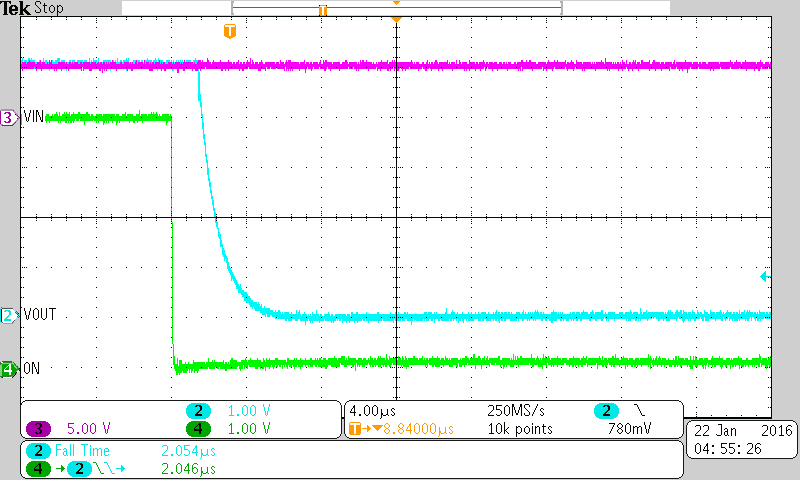
| VIN = 5 V | CIN = 1 µF | CL = 0.1 µF |
| RL = 10 Ω | QOD = Open |
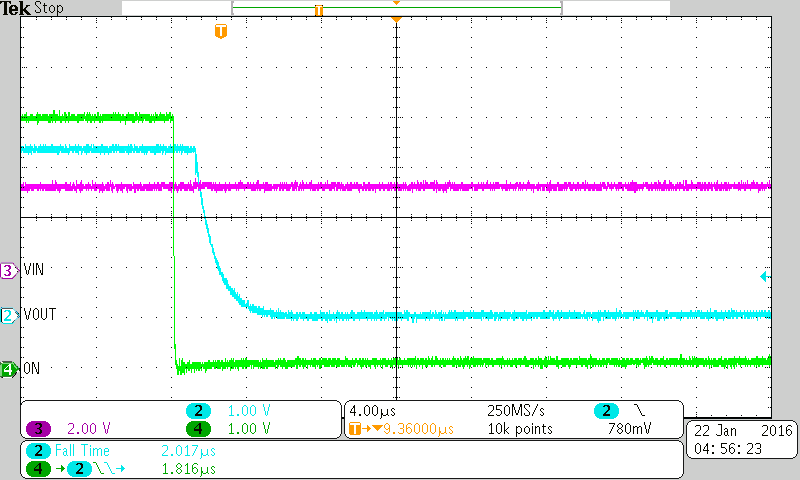
| VIN = 3.3 V | CIN = 1 µF | CL = 0.1 µF |
| RL = 10 Ω | QOD = Open |
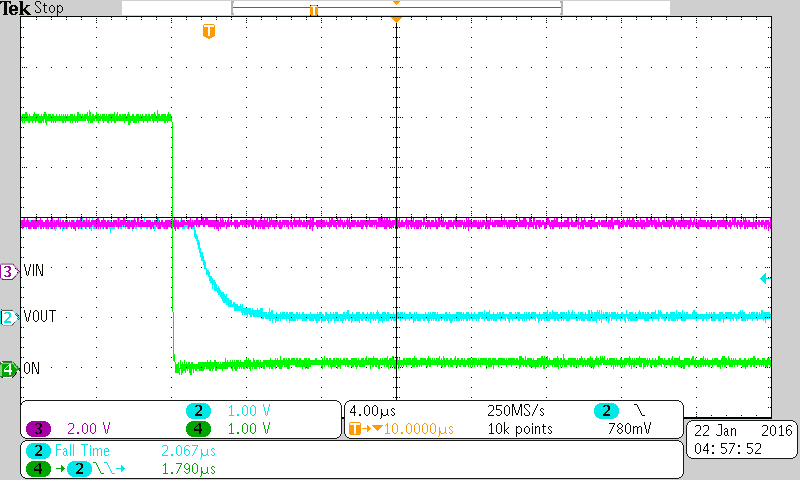
| VIN = 1.8 V | CIN = 1 µF | CL = 0.1 µF |
| RL = 10 Ω | QOD = Open |
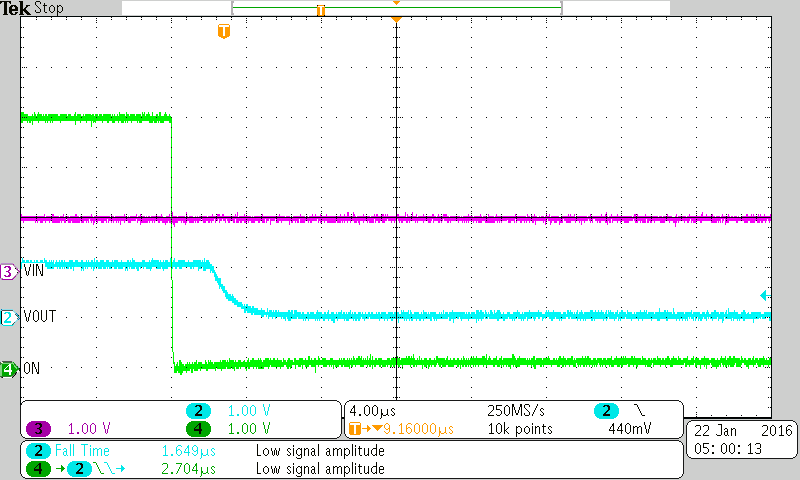
| VIN = 1.0 V | CIN = 1 µF | CL = 0.1 µF |
| RL = 10 Ω | QOD = Open |
